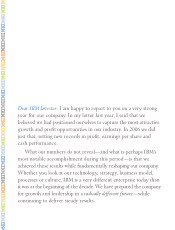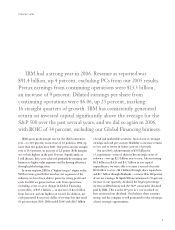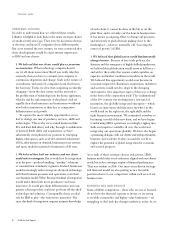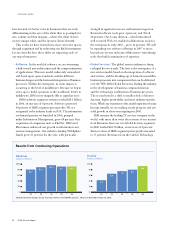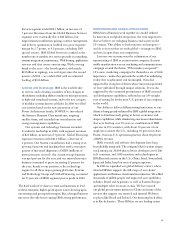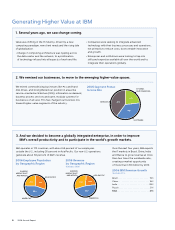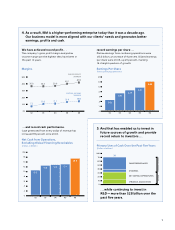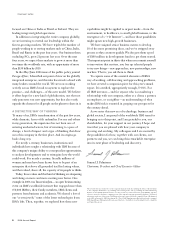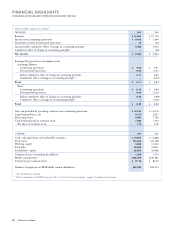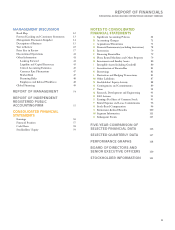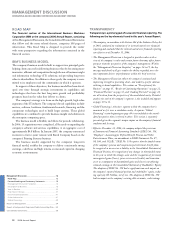IBM 2006 Annual Report Download - page 4
Download and view the complete annual report
Please find page 4 of the 2006 IBM annual report below. You can navigate through the pages in the report by either clicking on the pages listed below, or by using the keyword search tool below to find specific information within the annual report.2 2006 Annual Report
STRATEGIC CHOICES
In order to understand how we achieved these results,
I think it is helpful to look back to the major strategic choices
we made several years ago. They were by no means obvious
at the time, and most IT companies chose different paths.
But as we entered the new century, we were convinced that
three developments would be of paramount importance
to IBM and our clients:
1. We believed that our clients would place a premium
on innovation. What technology company doesn’t
say it’s all about innovation? But if you really take this
seriously, then you have to commit your company to
continuous adaptation and change. Such is the nature of
our industry, and many IT companies learn that lesson
the hard way. Today, it’s clear that computing is radically
changing
—
from the data center and the network to
the proliferation of technology into the home, appliances,
vehicles and the infrastructure of the planet. And it’s
equally clear that businesses and institutions worldwide
now look to innovation as their key to competitive
differentiation and growth.
To capture the most valuable opportunities, we’ve
had to change our mix of products, services, skills and
technologies. This is why we’ve exited businesses like
PCs and hard disk drives, and why, through a combination
of internal R&D shifts and acquisitions, we have
substantially strengthened our position in emerging,
higher-value spaces, such as service-oriented architecture
(SOA), information on demand, business process services
and open, modular systems for businesses of all sizes.
2. We believed that both our industry and our clients
would seek to reintegrate. But it would not be integration
as in the past
—
product bundling, “turnkey” solutions
or consolidation of industry segments. Instead, businesses
would increasingly seek to integrate advanced technology
with their business processes and operations, even their
core business model. Why? Because this kind of integration
would make them both more productive and more
innovative. It would give them differentiation and com-
petitive advantages they could not get from off-the-shelf
technology and solutions. Conceptually, this is an ideal
role for IBM to play
—
the “innovators’ innovator.” But
since this kind of integration requires intimate knowledge
of each client, it cannot be done in the lab or on the
plant floor, and it certainly can’t be done in headquarters.
It has meant an ongoing effort to change our processes
and structures to push decision making close to the
marketplace
—
what we internally call “lowering the
center of gravity” of IBM.
3. We believed that globalization would fundamentally
change business. Because of free trade policies, the
Internet and the emergence of highly skilled populations,
we believed that globalization would arrive in full force
—
and with it the reality that anyone could capitalize on
expertise and market conditions everywhere in the world.
We believed this opportunity would soon become an
economic imperative: Businesses, institutions, industries
and societies would need to adapt to the changing
environment. One important aspect of this was a change
in the form of the corporation itself. The “multinational”
of the 20th century was evolving into a new kind of
institution, the globally integrated enterprise
—
which
locates its operations and functions anywhere in the
world based on the right cost, the right skills and the
right business environment. We committed ourselves to
becoming a model of this new form, and we have begun
transforming IBM’s operations accordingly, tapping into
skills and expertise available all over the world and
integrating our operations globally. We have also begun
a promising dialogue with our clients and with government,
business and academic leaders around the world to
explore the potential of global integration for economic
and societal progress.
As a result of these strategic choices and actions, IBM’s
business model today is not only more aligned with our clients’
needs, but is also a stronger engine of financial performance.
That was evident in 2006. Our innovation-driven strategy
and financial model are also putting us in a favorable
position relative to our competitors within each area of our
business mix.
BUSINESS MIX AND RESULTS
Some of IBM’s competitors
—
those who are not as focused,
do not have the financial capacity to invest, or are trying
to straddle commodity and higher-value businesses
—
are
struggling to deal with the changes underway today. As we
Chairman’s Letter
black
MAC
2718

